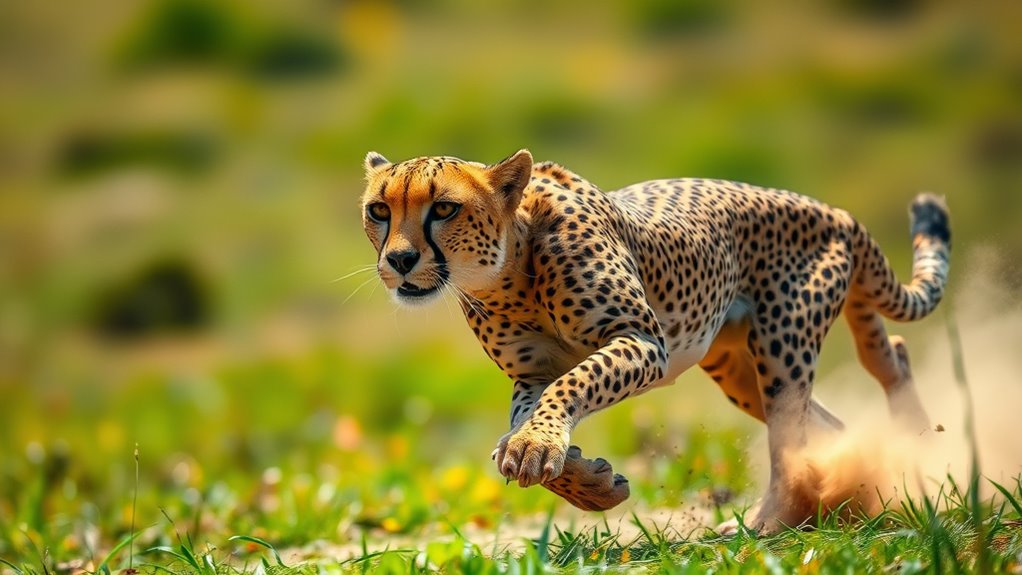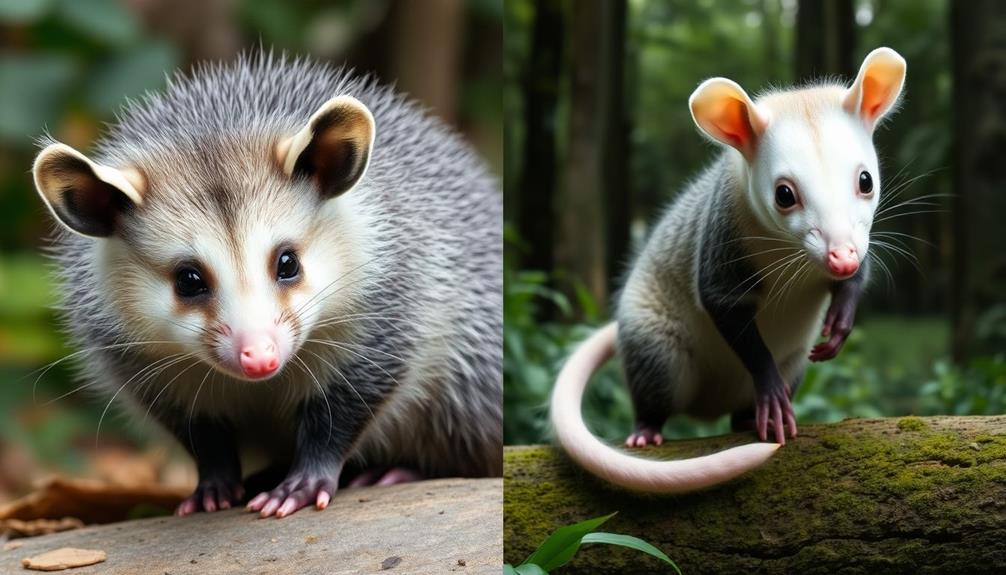A cheetah can run at incredible speeds of 60 to 70 mph in just seconds, making it the fastest land animal. It can go from 0 to 60 mph in around 3 seconds, perfect for chasing quick prey like gazelles. However, this speed is maintained only in short bursts lasting 20 to 30 seconds, resulting in quick fatigue. There’s a fascinating balance between their speed, hunting tactics, and survival skills that you might find interesting.
Key Takeaways
- Cheetahs can reach speeds of 60 to 70 mph in short bursts during hunts.
- They can accelerate from 0 to 60 mph in just 3 seconds.
- Their top speed is maintained for only 20-30 seconds due to high energy use.
- Cheetahs use speed to chase fast-moving prey like gazelles effectively.
- Their physical adaptations, such as long limbs and a lightweight frame, enhance their running capabilities.

Have you ever wondered just how fast a cheetah can really run? These magnificent creatures hold the title for the fastest land animals, capable of reaching astonishing speeds of up to 60 to 70 miles per hour in just a few seconds. Imagine that! In a mere sprint, a cheetah can cover a distance that would take you quite a while to walk. But their remarkable speed isn’t just for show; it plays a crucial role in their hunting strategies.
When you think about it, cheetah speed is essential for catching their prey. Unlike other big cats that rely on stealth and power, cheetahs have adapted to be sprinters. Their bodies are built for speed, featuring long, slender limbs, a lightweight frame, and a flexible spine that allows their legs to stretch farther with each stride. This unique anatomy enables them to accelerate from 0 to 60 miles per hour in just three seconds—a feat that even the most advanced sports cars struggle to achieve. It’s this explosive speed that allows cheetahs to chase down fast-moving animals like gazelles and impalas.
You might be surprised to learn that cheetahs can only maintain their breathtaking speed for short bursts, typically around 20 to 30 seconds. That’s why their hunting strategies revolve around quick, targeted efforts rather than prolonged chases. When a cheetah spots its prey, it uses a combination of stealth and speed to approach. It often hides in tall grass, blending in with its surroundings, before launching a rapid sprint to close the gap. Timing is everything; if they can get within 100 meters of their target, their chances of a successful catch increase dramatically.
However, the cheetah’s incredible speed comes at a cost. They quickly tire after their high-intensity chases, making them vulnerable if they don’t secure a meal. To compensate, they often hunt during the cooler parts of the day, like early morning or late afternoon, and utilize their keen eyesight to spot potential prey from a distance. Additionally, understanding transfer switch technology is essential for ensuring that backup power systems can seamlessly support households during outages, just as cheetahs adapt their hunting tactics for survival.
In the end, the cheetah’s speed isn’t just an impressive spectacle; it’s a critical aspect of their survival. By mastering their hunting strategies around their incredible speed, cheetahs have become one of nature’s most efficient predators, showcasing the perfect blend of power and agility in the animal kingdom.
Frequently Asked Questions
What Factors Affect a Cheetah’s Running Speed?
Several factors affect a cheetah’s running speed. Habitat influences play a significant role; open areas allow for longer sprints while dense vegetation can slow them down. Prey availability is vital too—if prey is scarce, cheetahs might not need to run as fast or often, impacting their speed over time. Additionally, physical condition and age can affect their performance, so staying healthy and agile is essential for maintaining that incredible speed.
How Long Can a Cheetah Maintain Its Top Speed?
A cheetah can typically maintain its top speed for about 20 to 30 seconds. During this brief burst, its hunting strategies become essential, as it aims to catch prey quickly. However, the energy expenditure is immense, making conservation efforts critical for their survival. You’ll find that understanding these dynamics not only highlights their incredible speed but also emphasizes the importance of protecting their habitats and ensuring they thrive in the wild.
Are Cheetahs Faster Than Other Big Cats?
When it comes to speed, the early bird catches the worm, and cheetahs definitely lead the pack. Cheetahs are faster than other big cats, reaching speeds of up to 60-70 mph in short bursts. This incredible speed gives them an edge in hunting strategies, allowing them to outpace prey. In a speed comparison with lions and tigers, cheetahs reign supreme, making them the ultimate sprinters of the feline world.
What Adaptations Help Cheetahs Run so Fast?
Cheetahs have several adaptations that help you watch them run so fast. Their lightweight bodies and long legs allow for quick acceleration, while large nasal passages provide more oxygen during sprints. Their unique hunting techniques involve quick bursts of speed, often in open habitats where they can see their prey. Additionally, their non-retractable claws provide better grip, aiding in sharp turns. This combination of traits makes them exceptional hunters in their habitat range.
How Do Cheetahs Accelerate Compared to Other Animals?
Cheetahs are like rockets on paws, accelerating faster than most animals. While a lion takes its time, cheetahs burst forward with powerful acceleration mechanisms, like their flexible spine and long legs. Compared to other creatures, they can reach top speed in mere seconds, leaving slower contenders in a cloud of dust. Their unique muscle fibers and lightweight bodies give them an edge, making their speed comparison truly astonishing. You’ll be amazed at their agility!
Conclusion
As the sun dips below the horizon, you watch a cheetah sprinting across the savanna, each stride a blur of power and grace. You can almost feel the ground tremble beneath its paws as it accelerates, reaching speeds of up to 75 miles per hour in mere seconds. You hold your breath, wondering how something so fast can also be so elegant. Just as it catches its prey, you realize: in the wild, speed isn’t just a skill—it’s survival.










